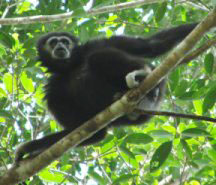Apes sing for protection
Apes sing for protection
mongabay.com
December 25, 2006
White-handed gibbons in Thailand use songs as a defense against predators according to a study by researchers at the University of St Andrews in Scotland and the Max Planck Institute in Germany.
The team — which included Esther Clarke, Klaus Zuberbühler and Ulrich Reichard — found that a gibbon’s song warns not only members of its own group but also gibbons in surrounding groups.
 Photo by Esther Clarke |
“We are interested in gibbon songs because, apart from human speech, these vocalisations provide a remarkable case of acoustic sophistication and versatility in primate communication,” the authors said in a statement. “Our study has demonstrated that gibbons not only use unique songs as a response to predators, but that fellow gibbons understand them.”
“This work is a really good indicator that non-human primates are able to use combinations of calls given in other contexts to relay new, and in this case, potentially life-saving information to one another. This type of referential communication is commonplace in human language, but has yet to be widely demonstrated in some of our closest living relatives – the apes.”
“We found that gibbons produce loud and conspicuous songs in response to predators to alert kin, both near and far — since gibbons frequently change group compositions, neighbouring groups often consist of close relatives. We found that gibbons appear to use loud long- distance’ calls to warn relatives in neighbouring areas and that those groups responded by joining in the singing, matching the correct predator song, demonstrating that they understood the difference between calls.”
The paper, titled “The syntax and meaning of wild gibbon songs”, is published in the journal PLoS ONE and is available online at: http://dx.doi.org/10.1371/journal. pone.0000073.
This article is based on a news release from the University of St Andrews.